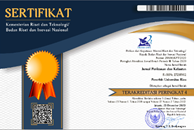Coral Reef Status after the 2018 Sunda Strait Tsunami Using the CPCe Program: A Case Study of Tanjung Lesung Banten
(1) Department of Marine Information System, Indonesia University of Education
(2) Department of Marine Information System, Indonesia University of Education; Department of Coastal Zone Development, Ministry of Marine and Fisheries Affairs
(3) Department of Marine Information System, Indonesia University of Education
(4) Department of Marine Information System, Indonesia University of Education
(5) Department of Marine Science, Faculty of Agriculture, Fisheries, and Animal Husbandry, Universitas Sembilanbelas November Kolaka
(6) Marine and Fisheries Officers Training Center, Agency of Research and Human Resources of Marine and Fisheries, Indonesia Ministry of Marine and Fisheries Affairs
(*) Corresponding Author
Abstract
Tsunami that swept the Tanjung Lesung coast in 2018 caused Anak Krakatau to collapse in Sunda Strait which hit the coastal areas of Banten and Lampung. Tanjung Lesung is one of the worst areas affected. Tsunami in Tanjung Lesung has taken lives, damaged infrastructure, and caused terrible natural damage. One of the damages affecting residents' lives in the Tanjung Lesung coastal community is exposure to the marine ecosystem. The main ecosystem that has the highest productivity level is the coral reef. Coral biota is the main benthic biota of reefs that are directly affected by earthquakes and tsunamis. Forms of damage to coral reef ecosystems include several coral colonies that were found broken, overturned and some died because they were covered by sediment. However, until now there has been no data on the status of coral reefs after the 2018 Sunda Strait tsunami. Therefore, researchers feel the urgency of this research is high enough to determine the condition of coral reefs after the Sunda Strait tsunami in Tanjung Lesung. There are 3 research stations for data collection before the tsunami, and we conduct research in those 3 stations again after the tsunami. Then we added 3 research stations again, so there are 6 research stations. Observation of coral reefs uses the Line Intercept Transect (LIT) method. The line transect is made by stretching a roll meter with a scale parallel to the coastline along 25 meters with three replications with an interval of about 0-5 meters between replications so the total observed transect was 75 meters. The deterioration of coral reef conditions at three research stations (1-3) proved that the tsunami waves affected the damage to coral reefs. This has an impact on the diversity of coral reef species inhabitants that have decreased. Disturbance form coral-damaged structure and composition changes of the base substrate as habitat can have an impact on reef fish and coral reef inhabitants. So that this research is expected to be a reference for policymakers in determining rehabilitation steps for areas affected by the 2018 Sunda Strait tsunami
Keywords
Full Text:
PDFReferences
Caldeira, K., & Wickett, M.E. (2003). Anthropogenic carbon and ocean pH. Nature. 425 (6956): 365. Https://doi.org/10.1038/425365a
English, S., Wilkinson, C., & Baker, V. (1994). Survey manual for tropical marine resources. ASEAN-Australia Marine Science Project: Living Coastal Resources
Estradivari., Syahrir, M., Susilo, N., Yusri, S., Timotius, S. (2007). Terumbu karang Jakarta: pengamatan jangka panjang terumbu karang Kepulauan Seribu (2004–2005). Yayasan TERANGI, Jakarta: 87hlm
Gomez, E.D. & Yap, H. (1988). Monitoring Reef Condition. Coral Reef Management Hand Book.Unesco Regional Office for Science and Technology for South East Asia. Jakarta.
Green., Morton, B., & New, S. (1996). Purchasing and Environmental Management: Interactions, Policies, and Opportunities. Business Strategy and Environmental.
Kamarumtham, K., Ahmad, Z., Halid, N.H., Saad, S., Khodzori, M.F.A., Yusof, M.H., Hanafiah, M.H.M. (2016). Diversity and Distribution of Coral Lifeforms in Tioman Island. Transactions on Science and Technology, 3(2): 367-373
Kartini, D.S., Mulyawan, R., & Yuningsih, N.Y. (2017). Kapitalisme Pedesaan di Kawasan Ekonomi Khusus (Kek) Tanjung Lesung Kabupaten Pandeglang Provinsi Banten. Jurnal Ilmu Pemerintahan. CosmoGov 55(3): 1
Krebs, C.J. (1985). Ecology: The experimental analysis of distribution and abundance. Harper & Row, New York. 800 p
Nontji, A. (1993). Laut Nusantara. Penerbit Djambatan. Jakarta.
Nybakken, J.W. (1988). Bilogi Laut Suatu Pendekatan Ekologis. Terjemahan M. Ediman, Koesoebiono, D.G Bengen, M. Hutomo, & S. Sukardjo. Jakarta: PT. Gramedia.
Odum, E.P. (1971). Dasar- Oceanography. 4ed. Thomson Learning, Inc.USA.
Purbani, D., Louise, T.K., Takwir, A. (2014). Kondisi Terumbu Karang Pulau Weh Pasca Bencana Mega Tsunami (Coral Reef Condition after Mega Tsunami Disaster). Jurnal Manusia dan Lingkungan, 21(3): 331-340
Wilkinson, C., David, S., & Jeremy, G. (2006). Status Terumbu Karang di Negara-Negara yang Terkena Tsunami 2005 (terjemahan). Institute of Marine Science, Townsville, Australia
Article Metrics
Abstract view : 182 timesPDF - 184 times
DOI: http://dx.doi.org/10.31258/jpk.28.1.116-124
Copyright (c) 2023 Luthfi Anzani, La Ode Alam Minsaris, Alya Dina Wilujeung, Cakra Rahardjo, La Ode Fajar Hasidu, Fajar Nugroho

This work is licensed under a Creative Commons Attribution-NonCommercial-NoDerivatives 4.0 International License.
Gedung Marine Center Lt 2. Fakultas Perikanan dan Kelautan Universitas Riau



